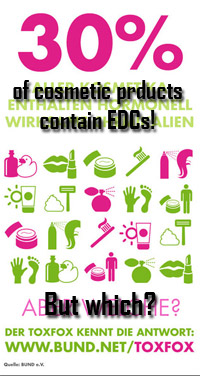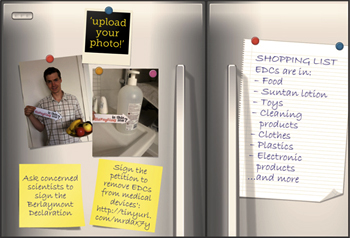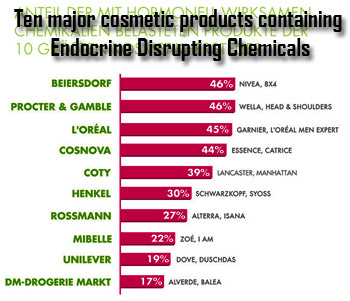Last week, on 23 July 2013, campaign group ClientEarth released a report indicating that manufacturers are ignoring, misrepresenting or disregarding the potential of certain Endocrine Disrupting Chemicals.
Endocrine disrupting chemicals are substances that act like natural hormones in the body. They are implicated in the health problems that occur worldwide in recent decades. Campaign group EDC Free Europe believe that our everyday exposure to all EDCs (endocrine disrupting chemicals), and not just bisphenol A – in our homes, workplaces and communities must stop in order to protect the health of current and future generations.
Damage to our health caused by EDCs include the decline in sperm quality, certain hormone-related cancers such as breast, prostate and testicular cancer and premature puberty in girls. Above all fetuses in the womb, babies and pubescent are threatened by endocrine-disrupting chemicals. Because these substances can interfere with the healthy development:
 Health Risk of EDC exposure in Adults:
Health Risk of EDC exposure in Adults:
Breast Cancer (both male and female),
Low quality sperm leading to infertility,
Testicular cancer
Health Risk of EDC exposure in Children:
Premature puberty
Reproductive malformations
The ClientEarth report, 'REACH registration and endocrine disrupting chemicals', is based on information made available by the European Chemical Agency (ECHA) about five such chemicals which are used in a wide range of everyday products, including children’s toys and personal care products like sunscreens and deodorants.
Industry is undermining European chemical safety with inadequate reporting of information, this is jeopardising the fundamental REACH principle of “no data, no market”.
The REACH regulations provides mechanisms to establish chemical safety and to encourage innovative substitution. The effective operation of REACH depends on a registrant providing data about a substance at the registration stage of REACH which is fit for the ambitious and precautionary (regulatory) purposes intended by REACH.
Since 1999, when the EU Commission first published the Community Strategy for EDCs, there has been a significant increase in the scientific knowledge about these chemicals, but those responsible for ensuring the safety of chemicals they place on the EU market have not adequately adapted their approach so that their REACH dossiers reflect this increase.
The research from ClientEarth indicates that, for a number of substances known to have endocrine disrupting properties, the dossiers are not of the quality required by REACH.
REACH is intended to protect public health and the environment and companies that register substances in the incorrect way should be held to account.
The five substances investigated in the report are diethyl phthalate, bisphenol A, tetrabromobisphenol A, triclosan and octyl-methoxycinnamate.
One of these chemicals, bisphenol A, has been the subject of previous news reports by Unionsafety; and is a carcinogen found in numerous and everyday food packaging products found in supermarkets across the globe. It can also be found in til receipts and ATM receipts.
 BPA is used in the manufacture of polycarbonate (PC) plastics, epoxy resins and other polymeric materials, and also for certain paper products (e.g. thermal paper).
BPA is used in the manufacture of polycarbonate (PC) plastics, epoxy resins and other polymeric materials, and also for certain paper products (e.g. thermal paper).
PC is used for food and liquid containers such as tableware (plates and mugs), microwave ovenware, cookware, reservoirs for water dispensers and non-food applications such as toys and pacifiers with PC shields.
BPA-based epoxyphenolic resins are used as protective linings for food and beverage cans and as a coating on residential drinking water storage tanks.
BPA is also used in a number of non food-related applications, e.g. epoxy-resin based paints, medical devices, surface coatings, printing inks and flame retardants.
Such is the seriousness with which the French are taking the danger to human health posed by bisphenol A, that they have decided to campaign in Europe for its complete banning from use in food packaging and other consumer products.
Further, a broad coalition of 27 not-for-profit organisations in France are calling on the French government to adopt an ambitious strategy to reduce exposure of populations and ecosystems to ALL endocrine disrupters.
The signatories comprise a diverse coalition of French civil society groups, including environmental groups, health insurance bodies, patients groups, consumers, unions and women’s groups.
The public petition, backed by a manifesto, reaffirms the need to act quickly and consistently on EDCs.
But according to the European Food Safety Authority (EFSA), it’s scientific experts have provisionally concluded that food is the main source of exposure to bisphenol A (BPA) for consumers. This is the Authority’s first review of exposure to BPA since 2006 and the first to cover both dietary and non-dietary sources such as thermal paper and dust.
However, EDCs are also present in a third of cosmetics and other beauty products commonly available throughout Europe, according to a Friends Of the Earth Germany study.
Following their study, and again last week, the German organisation on 24 July 2013, launched a smartphone application to make it easier for consumers to check if their cosmetics contain EDCs.
The Smart phone App is based on the study that Friends Of the Earth Germany (BUND) carried out using the data-bank of the Swiss Code-Check.info-platform http://www.codecheck.info/ which at that time comprised the lists of ingredients of 62,559 cosmetic products.
The code-check database is being continually compiled by critical consumers in German-speaking countries in a Wikipedia style system.
BUND screened the Code-Check data for 16 EDCs that emerged as critical for consumers’ health after cross-checking the EU-priority list for EDCs with the INCI-List (International Nomenclature of Cosmetic Ingredients).
The most striking results are that nearly a third of the 62.559 products contain EDCs. But there are EDC-Free alternatives out there on the market for example, shampoo and toothpaste. Natural cosmetics are generally EDC-Free whereas market leaders use the harmful substances in nearly half of their body care products.
 The main findings of the study by Bund are:
The main findings of the study by Bund are:
30 percent of all tested cosmetic products are hormonally charged.
Every fifth product contains several endocrine disrupters.
The proportion of contaminated products from leaders L'Oreal and Beiersdorf (Nivea etc.) is 45 to 46 percent.
The largest companies without EDC contaminated products are Naturkosmetik, Laverana Naturkosmetik, Logocos Naturkosmetik, Martina Gebhardt Naturkosmetik und Weleda Naturkosmetik.
The most common endocrine substance Methylparaben (a preservative) is in almost every fourth product.
The organisation's tool developed to help consumers to avoid products containing Endocrene Disrupting Chemicals is very easy to use and is continually updating its database:
Simple steps to using the ToxFox-App:
The bar-code of a product is scanned by the camera of the iPhone, then a green or a red symbol tells whether the product is EDC-Free or not.
A blue question mark appears when new products are scanned.
The App can also select data along product groups and companies.
Those without an iPhone or Smart phone can use the tool via BUND’s website here www.bund.net/toxfox
Before ending the search, individuals can send an email to the respective producer asking about the product.
The idea behind the tool is to provide consumers with the opportunity to protect their health and that of their children as long as legislative regulation of EDCs is insufficient.
Unfortunately, only German speakers are able to use the application.
Meanwhile, as part of a two-stage process of its full risk assessment, EFSA is seeking feedback on their draft assessment of consumer exposure to BPA. See Unionsafety news item: Food Is Main Source Of Carcinogen BPA For Consumers With Thermal Paper Also Potentially Significant, for full details and to download the consultation document.
All stakeholders and interested parties can provide their comments from 25 July to 15 September 2013. During a later stage, EFSA will publicly consult on the second part of its draft opinion, focusing on its assessment of the potential human health risks of BPA.

Campaign group EDC Free Europe, mentioned above, are a coalition of public interest groups representing more than 31 organisations across Europe have come together through a concern about endocrine disrupting chemicals (EDCs) and efforts to raise public awareness and urge quicker governmental action.
Their campaign partners include trade unions, consumers, public health and healthcare professionals, advocates for cancer prevention, environmentalists and women’s groups from across Europe.
They are asking the EU and national governments to swiftly:
- Revamp all relevant EU laws to reduce our exposure to EDCs
- Set out a timetable to capture all sources of EDC exposure ‘across the board’
- Respond more swiftly to early warning signals
- Enhance public awareness of EDCs
SSource: EFSA / Bund / ECHA / Unionsafety / EDC Free Europe
You can download the ClientEarth report from the E-library Database using search category 'Carcinogen'



 BPA is used in the manufacture of polycarbonate (PC) plastics, epoxy resins and other polymeric materials, and also for certain paper products (e.g. thermal paper).
BPA is used in the manufacture of polycarbonate (PC) plastics, epoxy resins and other polymeric materials, and also for certain paper products (e.g. thermal paper).  The main findings of the study by Bund are:
The main findings of the study by Bund are: